Termite Nest on Wall: Detect, Eliminate, and Learn
Discovering a termite nest on wall can be quite alarming for homeowners, as these tiny insects are notorious for causing extensive damage to wooden structures. In this blog post, we will delve deep into the fascinating world of termites and their intricate nests built on walls.
We’ll begin by exploring the origins and nature of termites, including their eusocial behavior and unique digestive abilities that allow them to consume cellulose-rich materials like wood. Next, we’ll examine the construction materials and techniques used by termites in building their nests – specifically how they utilize saliva-infused substances and bilayered constructs with dense cores surrounded by porous shells.
Moving forward, we will discuss the structural strength of termite nests on walls with particular focus on Odontotermes obesus species mounds. We will also highlight innovative research methods employed by scientists such as Lincy Zachariah to better understand these complex structures.
In addition, we’ll investigate ventilation systems within termite mounds that use microscopic pores for air circulation while providing thermal insulation through its porous nature. This knowledge is essential in identifying termite infestations in your property – whether it’s mud tubes along walls or fecal pellets from drywood termites – so you can take appropriate action before significant damage occurs.
Lastly, our discussion will cover effective ways to get rid of termites inside your home through consultation with professional exterminators who assess situations and determine specific types of invading termites. Furthermore, we’ll explore lessons learned from termite nest architecture that have potential applications in sustainable building design – an exciting area where engineers are drawing inspiration from self-regulating environments created by these incredible insects.
Table of Contents:
- The Origins and Nature of Termites
- Termite Nest Construction Materials and Techniques
- Structural Strength of Termite Nests on Walls
- Ventilation Systems within Termite Mounds
- Identifying Termite Nests on Your Property
- Getting Rid of Termites in Your Home
- Lessons from Termite Nest Architecture for Sustainable Building Design
- FAQs in Relation to Termite Nest on Wall
- Conclusion
The Origins and Nature of Termites
Termites are eusocial insects with advanced social organization, believed to have originated in the Carboniferous period about 359 million years ago. These fascinating creatures possess a unique ability to digest wood due to symbiotic gut-dwelling flagellates, making them notorious for causing damage to wooden structures. Let’s explore some key aspects of termites’ behavior and abilities:
Eusocial Behavior and Colony Organization
Termites live in colonies that can consist of millions of individuals, each playing a specific role within their community. They exhibit highly organized division of labor among different castes such as workers, soldiers, and reproductive members known as alates.
Unique Digestive Abilities
One remarkable characteristic that sets termites apart from other insects is their capacity to break down cellulose found in plant materials like wood. This feat is made possible by symbiotic microorganisms residing inside their guts, which help them process this otherwise indigestible substance into nutrients they can absorb.
In addition to being able to consume cellulose-rich substances like wood or paper products commonly found within human dwellings, termites also eat other organic matter such as leaves or even animal dung – all while constructing intricate nests on outer walls using termite saliva mixed with soil particles for added strength.
Termites are a fascinating species with complex behaviors and abilities, making them an important part of many ecosystems. Exploring the methods and elements used in creating their homes can provide us with knowledge on how termites interact with their environment.
Termite Nest Construction Materials and Techniques
Termites are known for their ability to create complex, self-regulating nests using a combination of saliva, dung, and soil. These materials work together to form structures that provide optimal living conditions for the colony members. The bilayered constructs consist of dense cores surrounded by porous shells, ensuring temperature and moisture control within the nest.
- Saliva-infused construction materials: Termites use their saliva as a binding agent when constructing their nests. This allows them to build strong walls that can withstand external pressure while maintaining an ideal internal environment.
- Bilayered constructs: By creating nests with dense cores surrounded by porous shells, termites ensure proper insulation and ventilation within the structure. This design helps maintain stable temperatures inside the nest even during extreme weather conditions outside.
The intricate architecture of termite mounds has fascinated researchers who study these insects’ building techniques in hopes of finding sustainable alternatives for conventional construction methods. For example, scientists have discovered that termites construct thousands of tiny windows or pores throughout their mounds which allow air circulation without affecting temperature or humidity levels inside – providing optimal living conditions for colony members (source). This innovative approach could potentially be applied in designing energy-efficient buildings inspired by termite nest architecture.
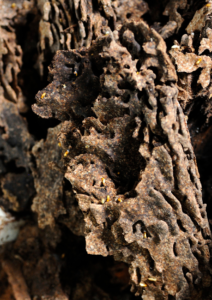
Termite nest and damage on wood underneath home flooring.
In order to protect your home from potential infestations caused by these industrious insects capable of causing significant damage over time due to their ability to eat away at wooden structures such as outer walls or foundations, it is crucial for homeowners to understand how termites build their nests and recognize the signs of an infestation early on.
Termite nests are complex structures that require the use of saliva-infused construction materials and bilayered constructs to ensure structural integrity. Building on this knowledge, researchers have explored the structural strength of termite mounds built by Odontotermes obesus species as well as innovative methods used in research like Lincy Zachariah’s.
Structural Strength of Termite Nests on Walls
Research has shown that termite mounds consist of incredibly strong earthen structures made from soil, water, and termite saliva. This combination results in remarkable strength properties, comparable even when recreated artificially in laboratory settings. Termites build these nests to provide a secure environment for their colonies while they feast on the cellulose found within wooden materials.
Odontotermes obesus Species Mound Characteristics
The Odontotermes obesus, a common termite species known for its nest-building abilities, creates impressive mounds using their unique construction techniques. These termites use their saliva to mix with soil particles, creating an adhesive substance that binds the dirt together and forms sturdy walls. The outer walls are designed to be porous yet robust enough to protect against predators and weather conditions.
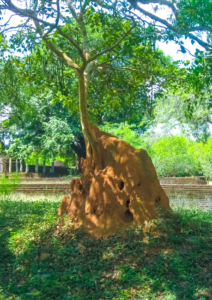
A termite mound taking over a tree in Sri Lanka.
Innovative Methods Used by Researchers like Lincy Zachariah
Lincy Zachariah, along with her team of researchers at the Indian Institute of Science Education and Research (IISER), has studied how termites construct such durable nests without any architectural knowledge or tools. They discovered that termites inside these nests secrete specific enzymes that break down wood fibers into simpler sugars – providing both an energy source as well as building material for further nest expansion.
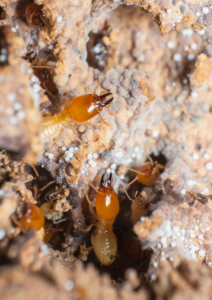
Damaged wood within termite nest. Soldier termites present.
To replicate this process in a lab setting, scientists mixed clay particles with water and termite saliva collected from various field samples. Surprisingly, this mixture exhibited similar structural strength compared to actual termite-built mounds, demonstrating the potential applications of these natural construction techniques in human-made structures.
The structural strength of termite nests on walls is a fascinating phenomenon, due to the intricate architecture and design employed by Odontotermes obesus species. Ventilation systems within these mounds are equally as intriguing; microscopic pores allow for air circulation while providing thermal insulation from their porous nature.
Ventilation Systems within Termite Mounds
One of the most fascinating aspects of termite nest architecture is their ability to create effective ventilation systems. Termites build nests with thousands of tiny windows, or microscopic pores, that facilitate air circulation without affecting temperature or humidity levels inside the nest. This provides optimal living conditions for the colony members and ensures their survival.
Microscopic Pores Facilitating Air Circulation
Termites construct these microscopic pores throughout their mounds using a combination of soil, water, and termite saliva. The porous nature of these materials allows air to flow in and out while maintaining stable internal conditions. As termites eat through wood structures in your home’s outer walls, they can inadvertently introduce this same ventilation system into your property – making it easier for them to thrive unnoticed.
Thermal Insulation Provided by Porous Nature
The unique construction techniques employed by termites not only provide efficient airflow but also offer excellent thermal insulation properties. The dense core surrounded by a porous shell helps maintain consistent temperatures within the mound despite external fluctuations. This ingenious design has even caught the attention of engineers seeking sustainable alternatives for conventional building methods.
In order to protect your home from potential infestations, it’s essential to be aware of how termites build nests and recognize any signs indicating their presence on your property early on. By understanding how these insects engineer such intricate structures complete with advanced ventilation systems, you’ll be better equipped to identify potential threats before they cause significant damage.
The intricate system of microscopic pores in termite mounds provide ventilation and insulation, making them an impressive example of nature’s engineering. Identifying the presence of a termite nest on your property is key to initiating treatment and preventing further damage.
Identifying Termite Nests on Your Property
Knowing how termites build nests can help homeowners identify potential infestations early on. By being vigilant and recognizing the signs of termite activity, you can take swift action to protect your home from these destructive pests.
Mud Tubes along Walls or Foundations
Subterranean termites, which are common in many parts of the United States, construct mud tubes as a means of traveling between their nest and food sources without being exposed to air. These tubes are made from soil, water, and termite saliva, providing a protected environment for termites. Look out for pencil-sized mud tubes running along your outer walls or foundations – this is often an indication that subterranean termites have infiltrated your property.
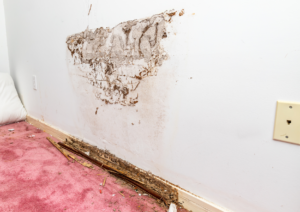
Termite infestation within side of residential wall.
Fecal Pellets and Wood Damage from Drywood Termites
Drywood termites live entirely within wooden structures they infest; thus, they do not create mud tubes like their subterranean counterparts. Instead, these termites eat wood from the inside out while leaving behind distinctive fecal pellets known as frass. If you notice small piles of frass around windowsills or baseboards accompanied by unexplained wood damage such as tiny holes or crumbling surfaces – it could be a sign that drywood termites have taken up residence in your home.
In addition to visual cues mentioned above, listen closely for faint clicking sounds coming from your walls, as this can also indicate the presence of termites inside your home.
Identifying termite nests on your property is essential to preventing further damage and destruction. Getting help from experts in pest removal is the best option for getting rid of termites rapidly and efficiently.
Getting Rid of Termites in Your Home
If you think termites may be present, it is critical to take immediate action. Termites can cause significant damage to your home’s structure and cost thousands of dollars in repairs if left unchecked. The importance of consulting a specialist, assessing the problem and determining what type of termites are present must be addressed when it comes to potential infestations.
Consulting with Professional Exterminators
The initial action to take when confronting a possible termite issue is to consult with an experienced exterminator. These experts have extensive knowledge about termites’ habits and life cycles and are equipped with specialized tools for effective treatment. They can accurately identify whether or not you have an infestation and recommend appropriate measures to eradicate them from your property.
Assessing the Situation and Determining Termite Types
Different types of termites require different treatment methods. For example, subterranean termites build their nests underground while drywood termites live inside wood structures like walls or furniture. To effectively eliminate these pests from your home:
- Inspect outer walls: Look for mud tubes along foundations that indicate subterranean termite activity.
- Check wooden structures: Inspect any exposed wood for signs that termites eat away at its interior – such as hollow-sounding timber or visible tunnels within beams.
- Fecal pellets: Drywood termites leave behind small piles of fecal pellets which resemble sawdust or coffee grounds. These can often be found near infested wood.
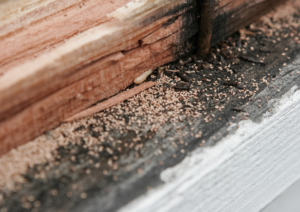
A Termite queen swollen with eggs crawls along the floor where damage and fecal droppings are present.
By taking swift action and working with a professional exterminator, you can protect your home from the costly damage caused by termites and ensure a safe living environment for you and your family.
Consulting with a professional exterminator is advised for optimal results when dealing with termite infestations in one’s residence. With that said, engineers can learn from studying termite nest architecture and apply those lessons to sustainable building design.
Lessons from Termite Nest Architecture for Sustainable Building Design
The study of termites’ building techniques has inspired engineers seeking sustainable alternatives for conventional construction methods. By examining how termites build their nests, we can potentially develop more energy-efficient buildings designed using similar principles employed by these industrious insects themselves.
Engineers Exploring Self-Regulating Environments
One key aspect of termite nest architecture is the self-regulating environment it creates. Termites use their saliva and soil to construct intricate mounds that maintain optimal temperature and humidity levels inside the nest. This ingenious design principle could be applied to human-made structures, leading to sustainable building designs.
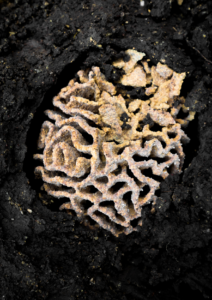
An advanced termite mound resembling a brain.
Potential Applications in Sustainable Building Design
- Natural ventilation: Just as termites create microscopic pores within their nests for air circulation without affecting internal conditions, architects could incorporate passive cooling systems into buildings – reducing reliance on energy-consuming air conditioning units.
- Biomimetic materials: The combination of termite saliva, dung, and soil results in incredibly strong earthen structures with remarkable thermal insulation properties. Researchers are exploring ways to mimic these materials in modern construction projects.
- Solar orientation: Termites carefully orientate their nests according to sun exposure patterns throughout the day; a concept which can be adapted when designing eco-friendly homes or commercial spaces that optimize natural light usage while minimizing heat gain during hot periods.
By learning from the ingenious construction methods of termites, we can develop innovative and sustainable building designs that not only benefit our environment but also reduce energy consumption and costs for homeowners.
FAQs in Relation to Termite Nest on Wall
How to Get Rid of a Termite Nest in Your Wall
If you suspect a termite nest in your wall, it’s important to act quickly. The first step is to consult with a professional exterminator to assess the situation and determine the type of termites present. They will recommend an appropriate treatment plan, which may include chemical barriers, baiting systems, or fumigation.
Do Termites Build Nests in Walls?
Yes, some species of termites can build nests within walls. Subterranean termites create mud tubes along walls and foundations for protection while traveling between their underground colony and food sources above ground. Drywood termites directly infest wooden structures like walls without needing soil contact.
What Happens if You Disturb a Termite Nest?
If you disturb a termite nest, the colony will likely disperse and relocate to another area within your property or nearby structures. This could lead to further damage as they continue feeding on wood materials elsewhere. It’s essential to seek professional help when dealing with active termite infestations.
What Happens if You Have Termites in Your Walls?
If left untreated, termites in your walls can cause significant structural damage over time due to their relentless consumption of cellulose found in wood materials. Early detection is crucial; signs include mud tubes along foundation lines or visible fecal pellets from drywood species.
Conclusion
Termites are fascinating creatures with unique abilities to construct intricate nests on walls using saliva-infused materials. Their eusocial behavior and digestive capabilities allow them to create bi-layered constructs that are both strong and porous, providing ventilation and thermal insulation.
If you suspect a termite nest on your wall, look for mud tubes or wood damage caused by drywood termites. It is advisable to consult with professional exterminators to assess the situation and determine the best course of action.
To protect your home from future infestations, consider sustainable building design inspired by termite nest architecture. Engineers are exploring self-regulating environments that could have potential applications in construction projects.
Protect your home from termites today. Contact Termite MD for expert advice and solutions!
All images used on this page were sourced using Canva Pro
- What is a Termite Tower and How to Get Rid of Them
- Termite Retreatment Vs. Treatment Vs. Extermination
- Terminix Pricing Options: What They Can Do for You
- Pest Control vs. Termite Control
- Most Popular Termite Products on Amazon
- Most Expensive and Cheapest Pest Control Companies
- Leading Pest Control Companies in USA
- How to Choose the Ideal Pest Control Company
- How to Choose a Termite Exterminator Company
- Green Termite Traps: How They Work
- Early Termite Detection Signs
- Does Pest Control Include Termites?
- Do You Have To Leave Your House When Exterminating Termites
- Best Termite Prevention Options
- 13 Mistakes People Make When They Have Termites
- Termite Pictures – Images of Infestation
- Top Picks: Best DIY Termite Products On Amazon
- Insect Growth Regulator: Home Termite Control Solution
- How to Choose a Pest Control Company for Termites
- 8 Effective Organic Termite Control Options for Homeowners